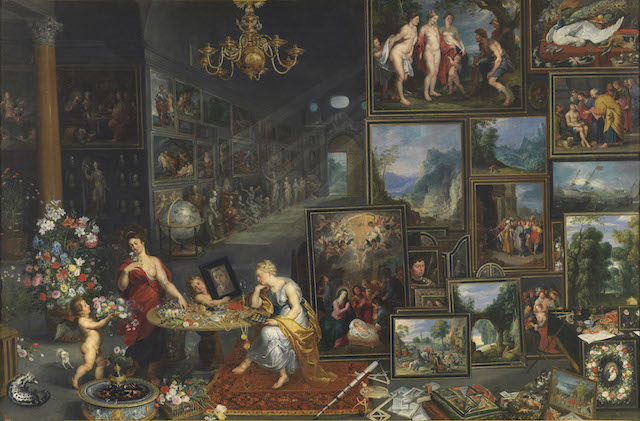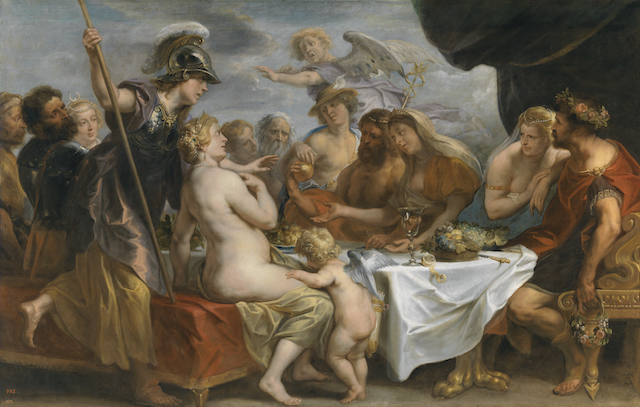![Titian (Tiziano Vecelli) (Italian [Venetian], c. 1488–1576), Venus with an Organist and Cupid, c. 1550–1555. Oil on canvas, 59 1/8 x 85 7/8 in. © Photographic Archive. Museo Nacional del Prado, Madrid](https://rogovoyreport.com/wp-content/uploads/2016/06/Venus-with-an-Organist-and-Cupid.jpg)
Titian (Tiziano Vecelli) (Italian [Venetian], c. 1488–1576), Venus with an Organist and Cupid, c. 1550–1555. Oil on canvas, 59 1/8 x 85 7/8 in. © Photographic Archive. Museo Nacional del Prado, Madrid
The Prado’s collection of Old Master paintings, widely recognized as one of the most important in the world, is characterized by a significant concentration of mythological, allegorical, historical, and religious paintings depicting nudes. The works presented in Splendor, Myth, and Vision were selected from the Prado’s unparalleled holdings, not only for their relationship to the exhibition’s themes, but also for their individual histories and artistic merit.
“It is a privilege for the Clark to bring this important collection of paintings to the United States and a great thrill to present them in our new galleries,” said Francis Oakley, interim director of the Clark. “Our collaboration with the Museo Nacional del Prado began when the Clark’s suite of paintings by Pierre-Auguste Renoir was presented in the Prado’s galleries in 2010 and became one of the most successful exhibitions in the Prado’s history. We are confident that this exhibition of the Prado’s masterpieces will be welcomed with equal fervor here and look forward to providing our visitors with a rare and wonderful opportunity to enjoy these exceptional works and to consider the rich historical themes explored in Splendor, Myth, and Vision.”

Jan Brueghel the Elder (Flemish, 1568–1625), Frans Francken II (Flemish, 1581–1642), Hendrik van Balen (Flemish, c. 1574/75–1632), Jan Brueghel the Younger (Flemish, 1601–1678), and others, Sight and Smell, c. 1618–23. Oil on canvas, 69 1/4 x 103 7/8 in. © Photographic Archive. Museo Nacional del Prado, Madrid
The exhibition explores the Spanish monarchy’s collection and display of sensual paintings during the sixteenth and seventeenth centuries in major works by Titian (Italian, c. 1488–1576), Peter Paul Rubens (Flemish, 1577–1640), Jacopo Tintoretto (Italian, 1519–1594), Diego Velázquez (Spanish, 1599–1660); Jusepe de Ribera (Spanish, c. 1591–1652), and Jan Brueghel the Elder (Flemish, 1568–1625), among others. The exhibition places particular emphasis on two of the greatest art patrons of their time: Philip II (r. 1556–1598) and Philip IV (r. 1621–1665). The exhibition includes important portraits of these patrons — Philip II painted by Titian in 1549–50, and Philip IV painted by Diego Velázquez, c. 1653–55.
Most of the works of art in the exhibition — many of which depict eroticized, mythological, female nudes — were made for or collected by a succession of Spanish kings as articulations of their secular and religious power, as reminders of virtue and vice, and as objects of private delight. A number of these paintings within the Spanish Royal Collections were secluded from public view in private, or reserved, rooms known as salas reservadas. When the Museo del Prado opened to the public in the nineteenth century, the tradition continued with many of the paintings of the nude being placed in a specially designated room. The museum’s sala reservada existed between 1827 and 1838.
The survival of paintings of the nude collected by the Spanish monarchy is a compelling story of the clash between public morals, private tastes, and the exercise of power. While Philip II and Philip IV celebrated depictions of the human form, Philip III (r. 1598–1621) was troubled by nudity and kept many works collected by his father out of sight, feeling that they were in conflict with his religiosity.
Even more extreme, Charles III (r. 1759–1788) and Charles IV (r. 1788–1808) considered having the paintings destroyed to avoid the moral corruption of those who might view them. Subsequently, many of these works were placed in the Academy of San Fernando with the dual intention of limiting public access to the paintings and providing pedagogical tools to students. More than two centuries later, the nude continues to evoke powerful responses across the spectrum of emotion, from censorship to celebrated acceptance.

Jacob Jordaens (Flemish, 1593–1678), Marriage of Peleus and Thetis, 1636–38. Oil on canvas, 71 1/4 x 113 3/8 in. © Photographic Archive. Museo Nacional del Prado, Madrid
The exhibition is the latest in a series of ongoing cultural exchanges between the Prado and the Clark. In 2010, the exhibition Pasión por Renoir, an exclusive presentation of the Clark’s suite of thirty-one canvases from its noted collection of works by the French Impressionist master, drew some 370,000 visitors, making it the fourth-highest attended exhibition in the Prado’s history. Javier Baron, the head of the Prado’s Nineteenth-Century Paintings Department and curator of Pasión por Renoir, subsequently completed a fellowship in the Clark’s Research and Academic Program (RAP) in 2011. In 2013, RAP welcomed Gabriele Finaldi, then the Prado’s Deputy Director for Collections and Research (and now the Director of the National Gallery, London) as a fellow.
Splendor, Myth, and Vision is accompanied by a fully illustrated catalogue (200 pages, $50) published by the Clark and distributed internationally by Yale University Press. Catalogue entries by Clark and Prado curators, among others, accompany an essay on the Spanish royal taste in collecting by Javier Portús, head of the Prado’s seventeenth-century Spanish painting department, and a contemporary response to understanding the nude in Renaissance and Baroque painting written by Jill Burke, senior lecturer in the history of art at the University of Edinburgh.
ABOUT THE CLARK
The Clark Art Institute, located in the Berkshires of western Massachusetts, is one of a small number of institutions globally that is both an art museum and a center for research, critical discussion, and higher education in the visual arts. Opened in 1955, the Clark houses exceptional European and American paintings and sculpture, extensive collections of master prints and drawings, English silver, and early photography. Acting as convener through its Research and Academic Program, the Clark gathers an international community of scholars to participate in a lively program of conferences, colloquia, and workshops on topics of vital importance to the visual arts. The Clark library, consisting of more than 240,000 volumes, is one of the nation’s premier art history libraries. The Clark also houses and co-sponsors the Williams College Graduate Program in the History of Art.
The Clark is located at 225 South Street in Williamstown, Massachusetts. Galleries are open Tuesday through Sunday, 10 am to 5 pm. Admission is $20; free year-round for Clark members, children 18 and younger, and students with valid ID. For more information, visit Clark Art Institute or call 413 458 2303.
ABOUT THE PRADO
The Museo Nacional del Prado is Spain’s premier art museum, founded by King Ferdinand VII in 1819 which has a collection of paintings from the twelfth to the early twentieth century. It houses the largest and most important collection of Velázquez, Goya, and Rubens in the world. It includes several of the great masterpieces of European painting, including Rogier van der Weyden’s Descent from the Cross, Bosch’s Garden of Earthly Delights, El Greco’s Portrait of a Man with his Hand on his Chest, Velázquez’s Las Meninas, and Goya’s The Second of May 1808 and The Third of May 1808. It also includes collections of ancient sculpture, decorative arts, and drawings, prints, and photographs, including the world’s largest and most important group of works on paper by Goya.
In 2007 the Prado opened its new extension, designed by Pritzker Prize-winning architect Rafael Moneo, which provides the Museum with new spaces for exhibitions, conservation, and storage. Information on the Prado’s collections and its exhibition program is offered in considerable detail on the Museum’s website, which includes valuable features such as the Online Gallery and a wide range of videos, in addition to various interactive functions on its PradoMedia channel. The Museum is also highly active on the internet through the social networks Facebook, Twitter, Google +, Foursquare, and YouTube, with a significant number of followers and interactions.
